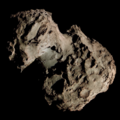427P/ATLAS
 Comet 427P/ATLAS photographed from the WIYN Observatory (left) and the Hubble Space Telescope (right).[1] | |
| Discovery[2] | |
|---|---|
| Discovered by | Aren Heinze |
| Discovery site | ATLAS–HKO (T05) |
| Discovery date | 27 September 2017 |
| Designations | |
| P/2017 S5, P/2021 L6 | |
| Orbital characteristics[4][5] | |
| Epoch | 23 November 2017 (JD 2458080.5) |
| Observation arc | 3.89 years |
| Earliest precovery date | 11 September 2017 |
| Number of observations | 438 |
| Aphelion | 4.163 AU |
| Perihelion | 2.178 AU |
| Semi-major axis | 3.171 AU |
| Eccentricity | 0.31304 |
| Orbital period | 5.646 years |
| Inclination | 11.849° |
| 252.39° | |
| Argument of periapsis | 99.944° |
| Mean anomaly | 20.594° |
| Last perihelion | 19 March 2023[3] |
| Next perihelion | 31 October 2028[3] |
| TJupiter | 3.092 |
| Earth MOID | 1.210 AU |
| Jupiter MOID | 1.664 AU |
| Physical characteristics[6][7] | |
Mean radius | 0.45 ± 0.06 km (0.280 ± 0.037 mi) |
| ~1.4 hours | |
| 0.06±0.02 | |
| (V–R) = 0.43±0.05 | |
| Comet total magnitude (M1) | 10.7 |
| Comet nuclear magnitude (M2) | 15.8 |
427P/ATLAS is a periodic comet and an active asteroid with a 5.65-year orbit around the Sun. It is the second comet discovered by the Asteroid Terrestrial-impact Last Alert System after 478P/ATLAS.[8]
Orbit
[edit]The comet orbits within the main asteroid belt at distances between 2.18 AU (326 million km) and 4.16 AU (622 million km) from the Sun.[4] Studies of its orbital trajectory revealed that it is highly likely a member of the Theobalda collisional family,[9] a group of asteroids formed from a large, shattered parent body about 7 million years ago.[10] The main-belt comets 455P/PANSTARRS and 483P/PANSTARRS also belong to this group.
Physical characteristics
[edit]Like most of the main-belt comets, the observed activity from 427P/ATLAS is driven by the sublimation of water ice on its surface, which its mass loss rate is estimated to be about ~5.0±3.0 kg/sec-1 during its perihelion in 2017.[11]
Photometric observations from the Lisnyky Observatory showed that this comet has some notable instability of color, likely caused by the injection of fresh material to its coma.[6]
Observations from the Hubble Space Telescope in 2019 had determined that its nucleus has an effective radius of 0.450±0.060 meters, assuming a geometric albedo of 0.06±0.02.[7][11]
References
[edit]- ^ "Shape-Shifting Asteroid with a Comet-like Tai". NOIRLab. National Science Foundation. 31 January 2019. Retrieved 3 June 2025.
- ^ A. Heinze; H. Sato; R. A. Kowalski; K. Sarneczky; O. Hanyecz; et al. (September 2017). D. W. Green (ed.). "Comet P/2017 S5 (ATLAS)". Central Bureau Electronic Telegrams. 4434 (1). Bibcode:2017CBET.4434....1S.
- ^ a b S. Yoshida. "427P/ATLAS". www.aerith.net. Retrieved 3 June 2025.
- ^ a b "427P/ATLAS – JPL Small-Body Database Lookup". ssd.jpl.nasa.gov. Jet Propulsion Laboratory. Retrieved 3 June 2025.
- ^ "427P/ATLAS Orbit". Minor Planet Center. Retrieved 3 June 2025.
- ^ a b S. Borysenko; A. Baransky; E. Musiichuk (2019). "Photometric observations of ecliptic comet 47P/Ashbrook–Jackson and selected quasi-Hilda and main-belt comets at Kyiv Comet Station (MPC code - 585) in 2017". Icarus. 317: 44–47. arXiv:2005.11143. Bibcode:2019Icar..317...44B. doi:10.1016/j.icarus.2018.07.003.
- ^ a b H. H. Hsieh; M. Micheli; M. S. P. Kelley; M. M. Knight; N. A. Moskovitz; et al. (2023). "Observational Characterization of Main-belt Comet and Candidate Main-belt Comet Nuclei". Planetary Science Journal. 4 (3): 43–65. arXiv:2302.11689. Bibcode:2023PSJ.....4...43H. doi:10.3847/PSJ/acbdfe.
- ^ "478P/ATLAS Orbit". Minor Planet Center. Retrieved 3 June 2025.
- ^ B. Novaković (2018). "P/2017 S5: Another Active Asteroid Associated with the Theobalda Family". Research Notes of the American Astronomical Society. 2 (3). arXiv:1807.08728. Bibcode:2018RNAAS...2..129N. doi:10.3847/2515-5172/aad412.
- ^ Y. Xin; J. Shi; Y. Ma (2024). "Research of the family associations of active asteroids in the main belt". Monthly Notices of the Royal Astronomical Society. 527 (4): 10309–10334. Bibcode:2024MNRAS.52710309X. doi:10.1093/mnras/stad3883.
- ^ a b D. C. Jewitt; Y. Kim; J. Rajagopal; S. Ridgway; R. Kotulla; et al. (2019). "Active Asteroid P/2017 S5 (ATLAS)". The Astronomical Journal. 157 (2): 1–8. arXiv:1812.00060. Bibcode:2019AJ....157...54J. doi:10.3847/1538-3881/aaf563.
External links
[edit]


